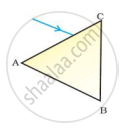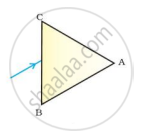Advertisements
Advertisements
Question
Write a relation for the angle of deviation (δ) for a ray of light passing through an equilateral prism in terms of the angle of incidence (i1) angle of emergence (i2) and angle of the prism (A).
Solution
The relation is i1 + i2 = A + δ
Replacing i2 by e the angle of emergence.
i1 + e = A + δ or [δ = (i1 + e) - A]
APPEARS IN
RELATED QUESTIONS
Define the term angle of deviation.
A ray of light is normally incident on one face of an equilateral glass prism. Answer the following:
What is the angle of refraction from the first face of the prism?
A ray of light is normally incident on one face of an equilateral glass prism. Answer the following:
What will be the angle of incidence at the second face of the prism?
In refraction of light through a prism, the light ray ______.
A ray of light suffers refraction through an equilateral prism. The deviation produced by the prism does not depend on the ______.
Draw a ray diagram to show the refraction of a monochromatic ray through a prism when it suffers a minimum deviation. How is the angle of emergence related to the angle of incidence in this position.
A prism ABC (with BC as base) is placed in different orientations. A narrow beam of white light is incident on the prism as shown in below Figure. In which of the following diagrams, after dispersion, the third colour from the top of the spectrum corresponds to the colour of the sky?
Draw a ray diagram showing the dispersion through a prism when a narrow beam of white light is incident on one of its refracting surfaces. Also indicate the order of the colours of the spectrum obtained.
The angle between two plane rectangular refracting surfaces of a prism is called as
State three factors on which the angle of deviation depends.




